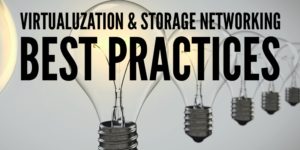Ever make a mistake configuring a storage array or wonder if you're maximizing the value of your virtualized environment? With all the different storage arrays and connectivity protocols available today, knowing best practices can help improve operational efficiency and ensure resilient operations. That's why the SNIA Networking Storage Forum is kicking off 2019 with a live webcast "Virtualization and Storage Networking Best Practices."
In this webcast, Jason Massae from VMware and Cody Hosterman from Pure Storage will share insights and lessons learned as reported by VMware's storage global services by discussing:
- Common mistakes when setting up storage arrays
- Why iSCSI is the number one storage configuration problem
- Configuring adapters for iSCSI or iSER
- How to verify your PSP matches your array requirements
- NFS best practices
- How to maximize the value of your array and virtualization
- Troubleshooting recommendations










 Ever make a mistake configuring a storage array or wonder if you’re maximizing the value of your virtualized environment? With all the different storage arrays and connectivity protocols available today, knowing best practices can help improve operational efficiency and ensure resilient operations. That’s why the SNIA Networking Storage Forum is kicking off 2019 with a live webcast “
Ever make a mistake configuring a storage array or wonder if you’re maximizing the value of your virtualized environment? With all the different storage arrays and connectivity protocols available today, knowing best practices can help improve operational efficiency and ensure resilient operations. That’s why the SNIA Networking Storage Forum is kicking off 2019 with a live webcast “


 is in the process of standardizing a TCP transport. It will be called NVMe over TCP (NVMe
is in the process of standardizing a TCP transport. It will be called NVMe over TCP (NVMe
Leave a Reply